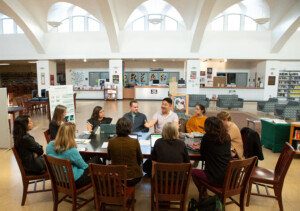Tomorrow’s College Tackles Higher Ed’s Greatest Challenges: Grit, Funding & Tech


As career fields increasingly require four-year degrees, it’s more necessary than ever before to be educated. The demand is driving many to endure debt, work excessive hours, and find alternative solutions to get ahead. Yet, the landscape of higher ed is changing. You can’t just check it off your list, you have to prove how college transformed your skills, attitude, and abilities.
“You’ve got to really learn something in school, gain some skills, learn to learn, and learn how to think,” said Emily Hanford, a reporter at American RadioWorks (ARW). “I think it means something really different for college today.”
ARW released three new documentaries to its annual Tomorrow’s College series this fall, which hones in on and evaluates some of the hard-hitting questions of higher education today: Why are so many college bound students failing to obtain a degree? How is for-profit education shaping the higher ed landscape? How is technology changing the way students attend college?
Why are so many college bound students failing to obtain a degree?
YES Prep Charter School Network has tapped the secret of college bound success by providing persistent educator support, delivering rigorous academics, and giving the right messages about hard work and perseverance. One hundred percent of its students make it into higher education, yet only 40 percent manage to graduate. The missing element to the YES Prep formula, Emily Hanford describes in “Grit, Luck and Money”, is grit.
“The ways that K-12 and higher education are changing will end up giving more opportunities to more people,” said Hanford. “I think the grit ideas and research is really interesting and exciting. Why does it have to be so hard for these low income students to get through college? It is harder for them. In general, the grit idea is more important.”
The concept of grit requires students to overcome obstacles, solve problems, and learn to struggle and subsequently succeed through grit. Yet, the big question is: Is it teachable? Teachers at YES Prep have mastered providing adequate support to push students through achievement, which falls short after graduation. There needs to be a greater connection between the K-12 classroom, college, and beyond.
“It seems pretty clear that students would benefit from a greater and smarter set of connections between the K-12 classroom and other environments no matter where they go,” said Stephen Smith, executive editor and host at ARW. “K-12 content versus critical thinking, individual knowledge acquisition, seem pretty patchy and not particularly well coordinated – whether or not they go to college.”
How is for-profit education shaping the higher ed landscape?
Facing the need to obtain a degree and the reality of life — a job, family, kids, or more gritty obstacles — many students are turning to online degrees, which give the flexibility and mobility many need who can’t drop everything and attend college on campus. Early entrepreneurs like John Sperling, founder of the University of Phoenix, saw the connection between the opportunity of online learning and the demand for flexible higher ed learning.
Since 1977, University of Phoenix has grown to be one of the largest for-profit higher education providers in the U.S. It’s controversy has served as a selling point to many students, allowing flexible learning hours amidst busy schedules with online learning and remote learning centers. Hanford’s “The Rise of Phoenix” brings to light why many students actually prefer online learning environments.
While many educators and education leaders fall queasy at the concept of for-profit learning, these institutions do provide some benefit, said Hanford and Smith. University of Phoenix and others like Western Governor’s University tend to be customer-centric, attracting a higher caliber of professors outside of Ivy leagues, and in some ways have greater interaction with students.
Many online schools or programs use a “high-touch approach,” said Smith. Professors call students up to ask about progress and understanding, view data on engagement and activity, or provide interactive, digital materials that stretch engagement beyond a giant lecture hall. Many students report getting to know their professors on a more personal, deeper level than ever before in a lecture hall setting.
How is technology changing the way students attend college?
Not only have online classes increased interaction, but the approach has increased the ability to reach more people at once. Massive open online courses (MOOCs) are leveraging online learning, smart-machine mentors, games, and more to reach students with cheaper, better access to learning across the globe. With the click of a mouse students can tap into the top professors and materials. “Keyboard College” by Smith looks at how technology for the first time has provided the watershed to the democratization of education.
“There’s pressure to deliver more with less,” said Smith. “It’s inevitable that technology will be adopted as a solution before its benefits and perils are understood. Online technology has the potential to be effective because it has the potential to be individualized.”
Hanford makes a great point in saying that while online courses, for-profit colleges, and MOOCs are risky investments for students – so is the traditional route, which is expensive, time-consuming, and demanding. No matter the path or college they choose, the chances of students entering college and leaving unfinished or with debt greater than their first year’s income is high.
“Change is happening. It’s happening rapidly. In part being driven by technology. In part by political and economic pressure to make graduate studies valid in the 21st century workforce,” said Smith. “I’m most interested in the question of how or whether higher education can open more opportunities in the workplace.”
The bottom line is that technology no doubt has had its impact on college, expanding the reach for those that could not typically afford traditional campus life. Yet, the success isn’t always in the dollars. It’s often times in the students’ grit and drive to be resourceful and succeed – a trait that is oftentimes unteachable without the obstacles we try so hard to remove for students’.
For more, visit americanradioworks.publicradio.org/features/tomorrows-college.
Photo courtesy of Big Stock. This blog first appeared on EdWeek.







0 Comments
Leave a Comment
Your email address will not be published. All fields are required.